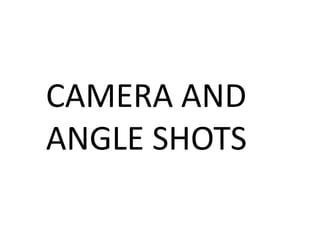
Camera shots-and-angles
- 2. •Camera angles The camera angle marks the specific location at which a movie camera or video camera is placed to take a shot. A scene may be shot from several camera. This will give a different experience and emotion. The different camera angles will have different effects on the viewer and how they perceive the scene that is shot. •Framing where the camera is placed in relation to the subject can affect the way the viewer perceives the subject. There are a number of camera angles, such as • Extreme long shots • Long shots • Medium shot •Close up •Extreme close up
- 3. 1 . Extreme long shot This can be taken from as much of a mile away, and is generally used as a scene-setting, establishing shot. It normally shows an the outside of a building, or a landscape, and is often used to show scenes of thrilling action eg in a war film or disaster movie. The shot is meant to give a general impression rather than specific information. 2. Long Shot This is generally one which shows the image as approximately "life" size that is corresponding to the real distance between the audience and the screen in a cinema. This category includes the FULL SHOT showing the entire human body, with the head near the top of the frame and the feet near the bottom. 3.Medium Shot Contains a figure from the knees/waist up and is normally used for dialogue scenes, or to show some detail of action. Variations on this include containing two figures from the waist up
- 4. 3.Medium Shot Contains a figure from the knees/waist up and is normally used for dialogue scenes, or to show some detail of action. Variations on this include containing two figures from the waist up. 4. Close-Up This shows very little background, and concentrates on either a face, or a specific detail. Everything else is just a blur in the background. This shot magnifies the object (think of how big it looks on a cinema screen) and shows the importance of expression on someone's face.
- 5. 5. Extreme close up As its name suggests, an extreme version of the close up, generally magnifying beyond what the human eye would experience in reality. An extreme close-up of a face, for instance, would show only the mouth or eyes, with no background detail whatsoever. This is a very artificial shot, and can be used for dramatic effect. •Angles 1. The Bird's-Eye view This shows a scene from directly overhead, a very unnatural and strange angle. Familiar objects viewed from this angle might seem totally unrecognizable. This shot does, however, put the audience in a godlike position, looking down on the action.
- 6. 2. High Angle Not so extreme as a bird's eye view. The camera is elevated above the action using a crane to give a general overview. High angles make the object photographed seem smaller, and less significant . 3. Eye Level A fairly neutral shot; the camera is positioned as though it is a human actually observing a scene.
- 7. 4. Low Angle These increase and give a sense of speeded motion. The background of a low angle shot will tend to be just sky or ceiling, the lack of detail about the setting adding to the disorientation of the viewer. 5. Oblique/Canted Angle Sometimes the camera is tilted (ie is not placed horizontal to floor level), (very popular in horror 6. An Ariel shot An exciting variation of a crane shot, usually taken from a helicopter. This is often used at the beginning of a film, in order to establish setting and movement. A helicopter is like a particularly flexible sort of crane - it can go anywhere, keep up with anything, move in and
- 8. •Rule of thirds The rule of thirds is a guideline which applies to the process of composing visual images such as designs,films,painting and photographs .The guideline proposes that an image should be imagined as divided into nine equal parts by two equallyspaced horizontal lines and two equallyspaced vertical lines, and that important compositional elements should be placed along these lines or their intersections.